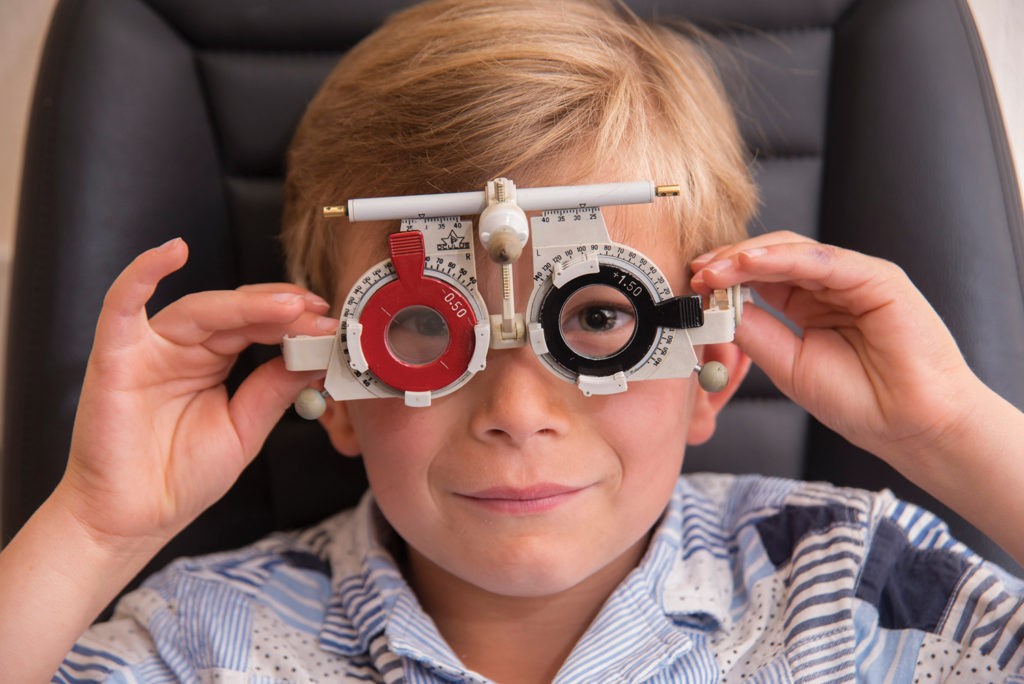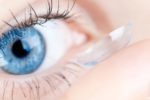Keeping Our Eyes on the Prize

August is nationally recognized as Children’s Eye Health and Safety Month.
Parents, physicians and advocates are working hard to spread awareness on children’s vision issues and the lifelong importance of routine vision care.
With summer in full swing, many parents are using the vacation days to get ready for the next year, scheduling things like dentist and doctor appointments. Healthy Kansas City magazine would like to encourage you to make vision care an additional top priority. According to the National Center for Children’s Vision and Eye Health (NCCVEH), one in five children has never undergone a vision test by a medical professional. Close to 175,000 American preschoolers struggle with common and treatable vision problems, with some of those vision problems leading to permanent vision loss. How we treat our children’s eye health now can seriously impact their lives in the future.
Start Vision Care Early
Parents commonly wait for children to say they are not seeing well before they take action. Unfortunately, children have no way of knowing what “normal” vision is and waiting until they complain of a problem means the problem has gone on much longer than necessary. Vision care should be part of every well-child check-up, and if you or your doctor suspects that your child may have a vision problem, you can make an appointment with your ophthalmologist for further testing. Ideally, children should see an eye doctor once a year.
According to an online survey of 1,008 parents conducted by KRC Research, in March of 2015:
- Only 2% of parents would wait for symptoms to develop to take their child a pediatrician or dentist.
- 25% of parents wait for symptoms before taking them to an eye doctor.
- Nearly 50% of parents with children under the age of 6 have taken them to see the eye doctor, though the number of eye exams recommended by age 6 is three.
In contrast, according to statistics provided by The Vision Council and the American Optometric Association:
- 1 in 4 children has a vision problem that can interfere with learning and behavior.
- 60% of problem learners have undetected vision problems.
- Some students diagnosed with learning disabilities actually have undiagnosed vision problems instead.
- 80% of everything children learn comes through their eyes.
Look for the Signs of Vision Problems
It is not always easy for parents to detect a vision problem in their child, and often mistake many problems for things like being tired. Parents may notice common signs of vision troubles in children which include: frequently rubbing eyes, squinting, tilting or turning head to look at objects, wandering eyes, or squeezing eyes. Amblyopia (lazy eye), Strabismus (crossed eyes), color deficiency (color blindness), and refractive errors (nearsightedness, farsightedness, and astigmatism) are the most common conditions that can affect a child’s vision. Many of these conditions, if diagnosed early, can be treated and vision can be restored. If the eye condition is not diagnosed until later in life, it can result in permanent vision loss and treatment will not be as effective.
Vision and Classroom Technologies
Many parents are concerned about the amount of screen time their children get, both at home and in the classroom. Classrooms today make full use of technology with many of them having computers, interactive whiteboards, digital devices, tablets, and 3D technologies to enhance the learning environment. Forty percent of teachers report using technology for instruction, with that number steadily rising each year. Many schools have replaced books with tablets on which students conduct homework and class activities.
When children are already spending a large amount of their free time on computers and other electronics, that adds up to a lot of screen time. Parents are understandably concerned. But is it actually harmful to vision? Well, yes, and no.
Science says parents can relax. So far, no evidence-based study has found that the use of technology causes vision problems, other than eye fatigue and dry eye. At most, excessive use may exacerbate existing problems.
According to a 2009 study conducted by the Council for Research Excellence, we are exposed to electronic screens – TVs, cell phones, computers, and tablets among them – for about 8.5 hours a day. When children fix their eyes in place and do not blink as often as they should, it can lead to dry eye. When the surface of the eye is dry, it starts to break down and it becomes easier for bacteria to enter and cause infection.
To remedy the problem, encourage children to take a break and follow the 20-20-20 rule. Every 20 minutes, look 20 feet away from the computer screen for 20 seconds. This will help the child blink more frequently which keeps the eyes wet and washes away dust.
Protecting Sight
Each year, thousands of children sustain serious eye damage and even blindness from accidents that occur at home or through activities such as sports, play, and recreational activities. Nearly one million Americans have lost some degree of vision due to an eye injury. Astonishingly, more than 90% of these injuries could be prevented through modified behaviors and the use of protective eyewear.
Sports injuries account for a large portion of eye injuries in children age 5 to 14 and most can be prevented with the appropriate eyewear. Many schools and sports leagues do not require the use of protective eyewear so parents mistakenly believe there is no danger. The best way to prevent sports eye injury is to wear appropriate, ANSI approved eye gear for all sporting activities.
According to Dr. Paul Berman, OD, FAAO, and Chairman of the Coalition to Prevent Sports Eye Injuries, “Children participating in any activity that uses a ball or racket, involves rough contact with other players, or requires moving at high speed – whether on a school team, in gym class or even just playing with friends – should wear protective eyewear including safety glasses, goggles, safety shields and eye guards.”
Injuries however, also occur outside of the sporting arena. Parents should additionally take care to protect their children’s eyes during extracurricular activities like swimming and crafts as well as in their daily lives, such as when helping with house or yard work.
Teach Children to be Eye Smart
It is easy to forget that even common items such as toys and household items can pose a risk of eye injury to children when misused. Each year, thousands of children sustain eye injury from toys that involve projectiles or sharp edges, or in some way did not meet safety standards. Common objects such as rubber bands, paper clips, pencils, scissors, wire clothes hangers, and bungee cords can also pose serious threats and when misused often leads to eye injuries in children.
For the safest toys, parents should look for toys marked “ASTM” which means it meets the safety standards set by the American Society for Testing and Materials. The use of toys, no matter how safe, should always be monitored for safety.
Children should also be trained on the use of common household items, so they understand the risks they pose. Dangerous items should always be kept out of the reach of younger and very small children or kept in a locked and secured area to avoid the items causing eye injury.
Protecting Toddlers Against Chemical Eye Injury
Researchers at Johns Hopkins Bloomberg School of Public Health studying 900 emergency room departments across the United States found that young children are the single highest risk group for ocular chemical injuries. The findings defy previously held assumptions, that adults who regularly work with chemicals in the workplace were most at risk. The study found that toddlers between 1 and 2 years old have the highest risk of burning their eyes with chemicals. The injuries were commonly caused by soaps and household cleaners that were improperly stored, and spray bottles left unattended. The risk decreases as children learn the dangers. In fact, 1 year olds are 13 times more likely to sustain a chemical eye injury than 7 year old children.
Fortunately, the chemical injury and their devastating effects can most often be avoided with the proper use and storage of all common household chemicals and keeping spray bottles well out of the reach of children, especially toddlers.
Healthy Kansas City magazine wants to encourage everyone to give our children the best opportunities to develop the best sight possible, and the skills to protect it for a lifetime.
For More Information
The Vision Council: www.thevisioncouncil.org/sites/default/files/SportsEyeSafetyReport.pdf
American Academy of Ophthalmology: www.aao.org/eye-health/tips-prevention/injuries-children
Prevent Blindness: www.preventblindness.org









